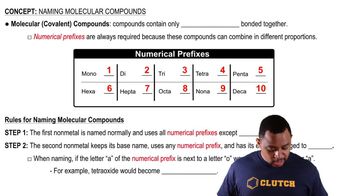Textbook Question
Complete the table by filling in the formula for the ionic compound formed by each pair of cations and anions, as shown for the first pair. Ion Na+ Ca2+ Fe2+ Al3+ O2- Na2O NO3- SO42- AsO43-
 Verified step by step guidance
Verified step by step guidance



Complete the table by filling in the formula for the ionic compound formed by each pair of cations and anions, as shown for the first pair. Ion Na+ Ca2+ Fe2+ Al3+ O2- Na2O NO3- SO42- AsO43-
Predict whether each of the following compounds is molecular or ionic: (a) B2H6
Predict whether each of the following compounds is molecular or ionic: (b) CH3OH
Predict whether each of the following compounds is molecular or ionic: (f) NOCl
Predict whether each of the following compounds is molecular or ionic: (h) Ag2SO4.
Predict whether each of the following compounds is molecular or ionic. a. PF5